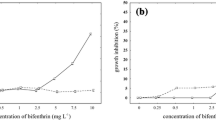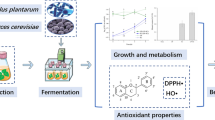Abstract
The degradation behaviour of pirimiphos methyl with Saccharomyces cerevisiae and chlorpyrifos methyl with Lactobacillus plantarum in wheat during fermentation was studied. Yeast fermentation was especially effective for reduction of pirimiphos methyl applied at 5 mg kg−1 (maximum residue limit—MRL) causing dissipation for max 48.8%. Pesticide reduction rate decreased with an increase of fortification rate. Thus in samples fortified with 25 and 75 mg kg−1 a reduction up to 27.1%, and 23.7% respectively, was observed. Activity of L. plantarum was especially effective for reduction of chlorpyrifos methyl applied at 3 mg kg−1 (MRL) causing dissipation for max 56.7%. This reduction rate decreased with an increase of fortification rate. In samples contaminated with 15 and 45 mg kg−1 dissipation reached up to 38.6% and 34.7% respectively. For both experiments, initial inoculums sizes had no statistically significant effect on pesticides dissipation level, while concerning fermentation temperatures at all fortification levels the highest degradations occurred at 30 °C. Overall, regardless fermentation parameters, the degradation rate constants of pirimiphos methyl fermented with yeast were increased comparing with control samples by 255–573, 56–116 and 119–594% in samples contaminated at MRL, 5MRL and 15MRL of pesticide, while the degradation rate constants of chlorpyrifos methyl fermented with lactobacilli were increased by 74–769, 59–237 and 46–469% respectively. These results evidenced that yeast and lactobacilli played an important role in promoting pirimiphos methyl i.e. chlorpyrifos methyl dissipation in wheat.
Similar content being viewed by others
References
Abou Ayana IAA, Gamal El Deen AA, El-Metwally MA (2011) Behavior of certain lactic acid bacteria in the presence of pesticides residues. Int J Dairy Sci 6:44–57
Abou-Arab AAK (1997) Effect of Ras cheese manufacturing on the stability of DDT and its metabolites. Food Chem 59:115–119
Abou-Arab AAK (2002) Degradation of organochlorine pesticides by meat starter in liquid media and fermented sausage. Food Chem Toxicol 40:33–41
Bi Fai P, Grant A (2009) A comparative study of Saccharomyces cerevisiae sensitivity against eight yeast species sensitivities to a range of toxicants. Chemosphere 75:289–296
Bo L-Y, Zhang Y-H, Zhao X-H (2011) Degradation kinetics of seven organophosphorus pesticides in milk during yoghurt processing. J Serbian Chem Soc 76:353–362
Boethling RS (1993) Biodegradation of xenobiotic chemicals. In: Corn M (ed) Handbook of hazardous materials. Academic, New York, pp 55–67
Braconi D, Sotgiu M, Millucci L, Paffetti A, Tasso F, Alisi C, Martini S, Rappuoli R, Lusini P, Sprocati AR, Rossi C, Santucci A (2006) Comparative analysis of the effects of locally used herbicides and their active ingredients on a wild-type wine Saccharomyces cerevisiae strain. J Agric Food Chem 54:3163–3172
Cabras P, Angioni A, Garau VL, Menelli EV, Cabitza F, Pala M (1998) Pesticide residue in raisin processing. J Agric Food Chem 46:2309–2311
Cabras P, Angioni A, Garau VL, Piris FM, Farris GA, Madau G, Emonti G (1999) Pesticides in fermentative processes of wine. J Agric Food Chem 47:3854–3857
Cho KM, Math RK, Islam SM, Lim WJ, Hong SY, Kim JM, Yun MG, Cho JJ, Yun HD (2009) Biodegradation of chlorpyrifos by lactic acid bacteria during kimchi fermentation. J Agric Food Chem 57:1882–1889
Clair E, Linn L, Travert C, Amiel C, Séralini G-E, Panof J-M (2012) Effects of roundup and glyphosate on three food microorganisms: Geotrichum candidum, Lactococcus lactis subsp. cremoris and Lactobacillus delbrueckii subsp. Bulgaricus. Curr Microbiol 64:486–491
Čuš F, Raspor P (2008) The effect of pyrimethanil on the growth of wine yeasts. Lett Appl Microbiol 47:54–59
Demir MK, Elgün A (2014) A Comparison of autoclave, microwave, IR and UV-C stabilization of whole wheat flour branny fractions upon the nutritional properties of whole wheat bread. J Food Sci Technol 51:59–66
Đorđević T, Đurović-Pejčev R (2015) Dissipation of chlorpyrifos methyl by Saccharomyces cerevisiae during wheat fermentation. LWT Food Sci Tech 61:516–523
Đorđević T, Šiler-Marinković S, Đurović-Pejčev R, Dimitrijević-Branković S, Gajić-Umiljendić J (2013a) Efficiencies of different methods for determination of organophosphate pesticide residues in fermented wheat substrate. Pestic Phytomed 28:133–140
Đorđević T, Šiler-Marinković S, Đurović-Pejčev R, Dimitrijević-Branković S, Gajić-Umiljendić J (2013b) Dissipation of pirimiphos methyl during wheat fermentation by Lactobacillus plantarum. Lett Appl Microbiol 57:412–419
Đurović R, Đorđević T (2010) Liquid-solid extraction method for pesticides determination in soil samples. In: Zbornik rezimea X Savetovanja o zaštiti bilja, Zlatibor, RS, pp 135–136 (in serbian)
Fleurat-Lessard F, Vidal M-L, Budzinski H (1998) Modelling biological efficacy decrease and rate of degradation of chlorpyrifos methyl on wheat stored under controlled conditions. J Stored Prod Res 34:341–354
Fleurat-Lessard F, Chaurand M, Marchegay G, Abecassis J (2007) Effects of processing on the distribution of pirimiphos methyl residues in milling fractions of durum wheat. J Stored Prod Res 43:384–395
González-Barreiro C, Rial-Otero R, Cancho-Grande B, Simal-Gándara J (2015) Wine aroma compounds in grapes: a critical review. Crit Rev Food Sci 55:202–218
González-Rodríguez R, Cancho-Grande B, Simal-Gándara J (2009) Efficacy of new commercial formulations to control downy mildew and dissipation of their active fungicides in wine after good agricultural practices. J Sci Food Agric 89:2625–2635
Goyal N, Jain SC, Banerjee UC (2003) Comparative studies on the microbial adsorption of heavy metals. Adv Environ Res 7:311–319
Islam SMA, Math RK, Cho KM, Lim WJ, Hong SY, Kim JM, Yun MG, Cho JJ, Yun HD (2010) Organophosphorus hydrolase (OpdB) of Lactobacillus brevis WCP902 from Kimchi is able to degrade organophosphorus pesticides. J Agric Food Chem 58:5380–5386
Jawich D, Lteif R, Pfohl-Leszkowicz A, Strehaiano P (2006) Effects of penconazole on two yeast strains: growth kinetics and molecular studies. Mol Nutr Food Res 50:552–556
Jung J-K, Park S-Y, Kim S-H, Kang J-M, Yang J-Y, Kang S-A, Chun H-K, Park K-Y (2009) Removal effects of Bifenthrin and Metalaxyl pesticides during preparation and fermentation of Baechu kimchi. J Korean Soc Food Sci Nutr 38:1258–1264
Kaushik G, Satya S, Naik SN (2009) Food processing a tool to pesticide residue dissipation—a review. Food Res Int 42:26–40
Kontou S, Tsipi D, Tzia C (2004) Stability of the dithiocarbamate pesticide maneb in tomato homogenates during cold storage and thermal processing. Food Addit Contam 21:1083–1089
Lalah JO, Wandiga SO (2002) The effect of boiling on the removal of persistent malathion residues from stored grains. J Stored Prod Res 38:1–10
Lu Y, Yang Z, Shen L, Liu Z, Zhou Z, Diao J (2013) Dissipation behavior of organophosphorus pesticides during the cabbage pickling process: residue changes with salt and vinegar content of pickling solution. J Agri Food Chem 61:2244–2252
Noguerol-Pato R, Torrado-Agrasar A, González-Barreiro C, Cancho-Grande B, Simal-Gándara J (2014) Influence of new generation fungicides on Saccharomyces cerevisiae growth, grape must fermentation and aroma biosynthesis. Food Chem 146:234–241
Noguerol-Pato R, Sieiro-Sampedro T, González-Barreiro C, Cancho-Grande B, Simal-Gándara J (2015) Evaluation of the effect of fenhexamid and mepanipyrim in the volatile composition of Tempranillo and Graciano wines. Food Res Int 71:108–117
Noguerol-Pato R, Fernández-Cruz T, Sieiro-Sampedro T, González-Barreiro C, Cancho-Grande B, Cilla-García DA, García-Pastor M, Martínez-Soria MT, Sanz-Asensio J, Simal-Gándara J (2016) Dissipation of fungicide residues during winemaking and their effects on fermentation and the volatile composition of wines. J Agric Food Chem 64:1344–1354
Razmkhab S, López-Toledano A, Ortega JM, Mayen M, Merida J, Medina M (2002) Adsorption of phenolic compounds and browning products in white wines by yeasts and their cell walls. J Agric Food Chem 50:7432–7437
Regueiro J, López-Fernández O, Rial-Otero R, Cancho-Grande B, Simal-Gándara J (2015) A review on the fermentation of foods and the residues of pesticides—biotransformation of pesticides and effects on fermentation and food quality. Crit Rev Food Sci 55:839–863
Ruediger GA, Pardon KH, Sas AN, Godden PW, Pollnitz AP (2005) Fate of pesticides during the winemaking process in relation to malolactic fermentation. J Agric Food Chem 53:3023–3026
Russo P, Beleggia R, Ferrer S, Pardo I, Spano G (2010) A polyphasic approach in order to identify dominant lactic acid bacteria during pasta manufacturing. LWT Food Sci Technol 43:982–986
Salgado JM, González-Barreiro C, Rodríguez-Solana R, Simal-Gándara J, Domínguez JM, Cortés S (2012) Study of the volatile compounds produced by Debaryomyces hansenii NRRL Y-7426 during the fermentation of detoxified concentrated distilled grape marc hemicellulosic hydrolysates. World J Microb Biot 28:3123–3134
Santos PM, Simões T, Sá-Correia I (2009) Insights into yeast adaptive response to the agricultural fungicide mancozeb: a toxicoproteomics approach. Proteomics 9:657–670
Sharma J, Satya S, Kumar V, Tewary DK (2005) Dissipation of pesticides during bread making. Chem Health Safety 12:17–22
Shin J-H, Kim Y-M, Park J-W, Kim J-E, Rhee I-K (2003) Resistance of Saccharomyces cerevisiae to fungicide chlorothalonil. J Microbiol 41:219–222
Singh BK, Walker A (2006) Microbial degradation of organophosphorus compounds. FEMS Microbiol Rev 30:428–471
Singh BK, Walker A, Morgan AW, Wright DJ (2004) Biodegradation of chlorpyrifos by Enterobacter strain B-14 and its use in bioremediation of contaminated soils. Appl Environ Microb 70:4855–4863
Uygun U, Senoz B, Ozturk S, Koksel H (2009) Degradation of organophosphorus pesticides in wheat during cookie processing. Food Chem 117:261–264
Zhao X-H, Wang J (2012) A brief study on the degradation kinetics of seven organophosphorus pesticides in skimmed milk cultured with Lactobacillus spp. at 42 °C. Food Chem 131:300–304
Acknowledgements
This study was carried out as a part of the Project No TR31043, supported by the Ministry of Education and Science of the Republic of Serbia.
Author information
Authors and Affiliations
Corresponding author
Rights and permissions
About this article
Cite this article
Đorđević, T.M., Đurović-Pejčev, R.D. The potency of Saccharomyces cerevisiae and Lactobacillus plantarum to dissipate organophosphorus pesticides in wheat during fermentation. J Food Sci Technol 53, 4205–4215 (2016). https://doi.org/10.1007/s13197-016-2408-4
Revised:
Accepted:
Published:
Issue Date:
DOI: https://doi.org/10.1007/s13197-016-2408-4




